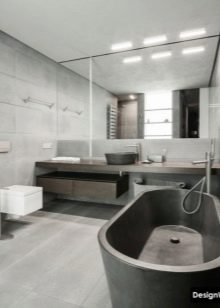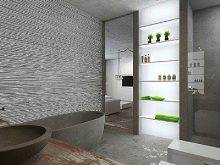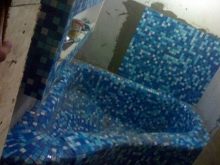Concrete baths: pros and cons, examples in the interior

There are fierce debates over whether to buy a bathtub made of steel or acrylic, cast iron or wood. Against this background, the proposal to use a "bathing platform" made of concrete looks somewhat unexpected. Although it deserves more attention than is usually thought. And there are many reasons for this.



Peculiarities
It is possible to use concrete bathtubs in an apartment not only in ultra-modern high-tech interiors. The advantage of this design is that it can be either purchased ready-made or made independently. In this case, strictly individual characteristics are achieved. If you have at least minimal experience with building mixes, there will be no problems.
But before you make a monolithic structure of concrete or find out where it can be ordered, you first need to figure out if this makes sense.


Advantages and disadvantages
It is quite obvious that even rather weak concrete is very strong and is not too inferior in this parameter to steel or cast iron. More often, only the easily repairable outer coating of the sanitary ware will be damaged. The structure itself is practically invulnerable, especially if you do not break it on purpose. The second advantage is logically related to the first: a concrete bath can be used for a very long time. Manufacturers of even old panel constructions guaranteed the life of the houses not less than 50 years.



There is no reason why a bathtub would work less. Moreover, the full service life of artificial stone structures may well be hundreds of years. However, this decision has a number of negative aspects that cannot be ignored:
- the difficulty of forming the formwork;
- significant mass;
- the inability to get access to the water discharge points, therefore you have to spend a lot of money on the most reliable pipes, siphons, which are possible.


Shapes and sizes
When choosing the size of a concrete bath, you need to take into account how spacious the bathroom will be. After installing the bathing container, there must be enough space to move freely. If the product is intended for children, the required depth is 0.5-0.6 m. The width of the bathtub is made such that at least a few centimeters remain from the shoulders of those who fit in it to the walls.
It will be quite nice if this product is a little wider, then the comfort is ensured.



When determining the size of a concrete bath, they also pay attention to the following points:
- sink parameters;
- armrests;
- angles of inclination of the sides;
- shelves, niches installed next to each other, various furniture and plumbing (so that they do not interfere with each other).
Traditionally, the most demanded option is rectangular bath. It can have a variety of sizes, and such products will suit both children and adults alike. The corner configuration is mainly chosen if there is not enough space. But this form may also be associated with the desire to emphasize the unusual design of the bathroom. Corner sizes are flexible and the only general requirement is to maintain symmetry.



An oval concrete bathtub is appreciated primarily for its external uniqueness and maximum originality... Such structures do not need to be pushed close to the wall - moreover, in the middle of the room their aesthetics are revealed as fully as possible. The oval softens the external roughness of the concrete. However, it should be borne in mind that this form does not allow the use of:
- headrests;
- armrests;
- seat.
The shape of the circle attracts the attention of those who want not just to stand out, but to shock others... A round concrete bathtub is usually made in a double or multi-seat version. Of course, if free space permits. It is impractical to make a product with a diameter of more than 2.1 m - even with this size it weighs very significantly.



Another option for creating a non-standard setting is the use of square baths. This form will organically fit into any layout. Usually it is used in such a way that the font becomes the dominant feature of the room.
To emphasize the unusualness of the layout, they are well suited asymmetrical baths. They also allow you to get away from strict and unambiguous lines. But for obvious reasons, the creation of such a structure from concrete is very difficult, and only very experienced people can carry out this plan.
Returning to the dimensions, we can point to such a universal selection of sizes that suits almost all people:
- length - 1.4, 1.5, 1.6 or 1.8 m;
- width - 0.7, 0.8, 0.85 m;
- height - 0.65 m.



Cladding materials
The strength of concrete does not justify its important drawback: this material looks rather boring. Touching a clean cement surface is not very pleasant, and direct exposure to water can greatly shorten the life of the structure. The way out is surface cladding with various materials... The simplest way to do this is use of ceramic tiles.
This work can be done quickly, but if there is at least one oblique line or curved surface, this option will have to be abandoned.



Therefore, owners of round, oval bathtubs should immediately forget about tiles. If there are no problems with the shape, you will have to prime the surface before gluing the tiles and then plant the tiles on tile glue. The grout is selected with extreme hydrophobic properties. Covering the bathtub with mosaics is acceptable even in cases where the tiles are categorically unsuitable. The work itself is carried out on approximately the same principles.



Another option - pouring liquid acrylic. It is made after plastering with a hydrophobic filler.And this putty is applied strictly after the installation of the reinforcing mesh. Then a high mechanical strength of the structure is guaranteed.
Acrylic is mixed with a hardener strictly in a certain proportion, which is determined by the instructions from the manufacturer.



Beautiful examples in the interior
This photo clearly shows how unjustified the common idea of the roughness and mediocrity of a concrete bath. If you place such a product in the atmosphere of a loft, a kind of charm will appear. The discreet gray and black components only add to this impression. The use of local lighting from the ceiling to separate parts of the room turns out to be an appropriate solution.
Sharp "chopped" edges of all objects, including the bath itself, turn out to be quite logical.

And this is what another version of concreted bathtubs looks like. A rectangular product beveled on one side fits snugly against the wall. The color of the wall itself is fully consistent with the color of the bath. The contrast turns out to be a noticeably lighter and more graceful floor. An unexpected design note in the form of starfish accessories looks quite appropriate,

And here is a round concrete bathtub. It is relatively short. The color of the font and the color of the floor are almost the same. At the same time, an expressive contrast is observed with a light wall. An ornamental plant helps to dilute the excessive rigidity of the interior.


How to choose a bath is described in the next video.









Thank you very much for the information! I found a lot of new things for myself.
As for the formwork, you can lay it out of bricks or blocks, and then coat it. Then the drain point can simply be drilled.